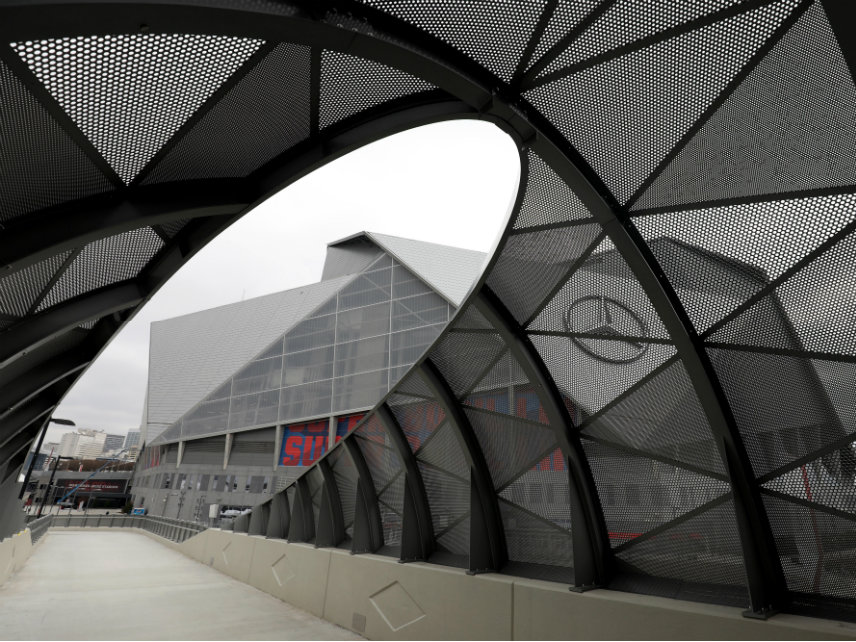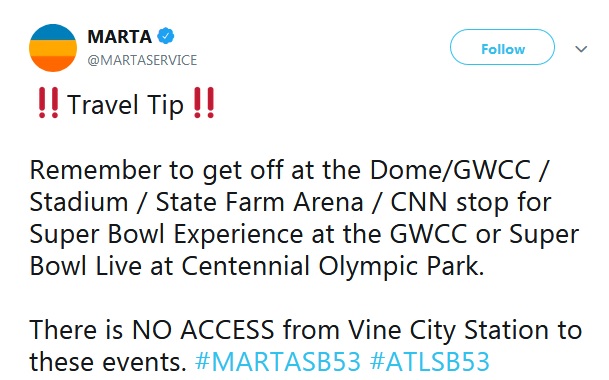Atlanta Spent $23 Million Building a Pedestrian Bridge for the Super Bowl That Pedestrians Can't Use
And even if fans could use it, $23 million is an insane amount of money to spend for a pedestrian bridge.

You've heard of the "bridge to nowhere." Now meet Atlanta's bridge for no one.
In anticipation of hosting this year's Super Bowl at the brand new Mercedes-Benz Stadium, the city of Atlanta spent more than $23 million to build a pedestrian bridge linking the stadium to the nearby Vine City public transit station, allowing fans to cross a busy street without needing a crosswalk. The bridge was originally supposed to cost about $13 million—already pretty pricey for a simple pedestrian crossing over a four-lane road—but city officials approved an extra $10 million in funding last year to ensure the project would be finished in time for the big game, which kicks off Sunday evening.
The serpentine bridge—decked out with dazzling, customizable LED lights and wrapped with diamond-shaped aluminum panels—did indeed get finished in time for the Super Bowl.
But it won't be used by the vast majority of the expected 80,000 people heading to the game on Sunday. Because of it's location adjacent to the stadium, the bridge has been deemed a security risk and will be closed to everyone except credentialed staff and media, the Atlanta Journal-Constitution reported this week.
Fans heading to the Super Bowl will have to enter through various security check-points well outside of the stadium grounds. That means anyone arriving at the Vine City station on the other side of the $23 million pedestrian bridge will get to admire a very expensive piece of public art as they cross the street the old fashioned way—though the bridge will be "open for attendees to exit at the conclusion of the game," the Atlanta Falcons told the paper.

Even by Atlanta's standards, paying $23 million to build a bridge that no one can use is a pretty incredible screw-up. This is, after all, the same city that spent $98 million building a streetcar line that's literally useless for anyone except tourists—it runs in a 2.7-mile loop downtown around the Coca-Cola Museum, Centennial Olympic Park, and the new football stadium—then closed the streetcar when some 100,000 tourists descended on the city for last year's college football national championship game.
Just outside the city, the Atlanta Braves' new stadium—a disaster for taxpayers and fans in several ways, as I've detailed before—had its own issues with a pedestrian bridge that was supposed to connect the stadium with a large parking garage on the opposite side of Interstate 285. The bridge wasn't ready until the Braves' second season at SunTrust Park, leaving the team with inadequate parking (and forcing fans to play a human version of Frogger) when the new field opened.
Despite those issues, the Braves' pedestrian bridge across eight lanes of highway cost a mere $11 million—less than half of the final price tag for the now-useless pedestrian bridge at the Falcons' new stadium, which crosses a four-lane city street.
"That's how the City wants to impress out-of-town visitors. Not with our civil rights legacy, our cultural icons, our southern soul food, our urban tree canopy, or our welcoming diverse people," wrote Lauren Welsh, an Atlanta-based activist, in a post for the ThreadATL blog. "Instead, we believe tourists will think Atlanta is awesome because we have a snakeskin light-up bridge to cross a 4-lane road."
The unseen cost of this pedestrian bridge—like other urban boondoggles—is worth considering, too. What else could the city have done with the $23 million spent on this project? What else could Atlanta taxpayers have done with that money if it wasn't expropriated from them in the first place? Smart urban planning requires city officials to allocate finite resources to cover a wide variety of expenses while preparing for unexpected surprises. Spending $23 million on a foot bridge is a terrible decision, even without the embarassment of having it closed for the very event for which you spent an extra $12 million.
The extra spending is particularly galling because is was approved less than a year before the Super Bowl was heading to Atlanta. Surely, someone could have checked with the NFL or the FBI (which handles security issues for the Super Bowl) about the extent of the planned security perimeter for the big game. Those things are carefully planned—certainly more carefully planned than this pedestrian bridge appears to have been.
When the bridge was first proposed, the Atlanta Journal-Constitution reported last year, city officials claimed it had nothing to do with the new stadium. It was supposed to be a way to connect the city's Vine City neighborhood to the downtown and just happened to be located immediately adjacent to the stadium. But when the city council approved the additional funding for the bridge in March of last year, an aide to the mayor's office explicitly connected the bridge project to the Super Bowl. "It's time-sensitive," Katrina Taylor-Parks, deputy chief of staff to Mayor Keisha Lance, told the paper.
And it got done on time. That's about the only part of this story that makes Atlanta look good.


Show Comments (55)